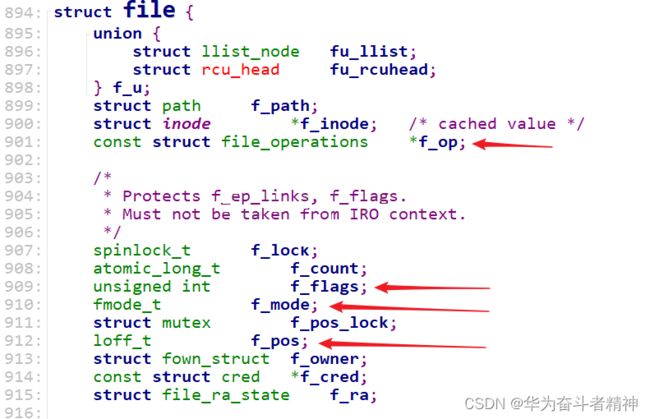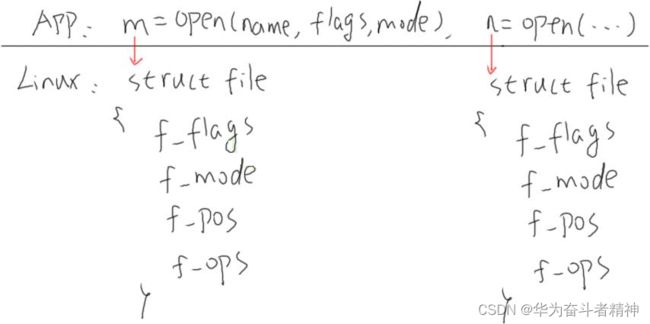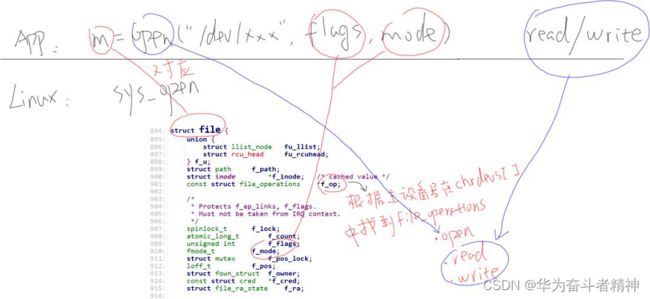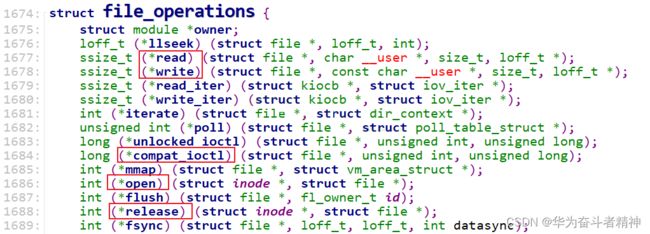嵌入式Linux应用开发-基础知识-第二章 Hello驱动
嵌入式Linux应用开发-基础知识-第二章 Hello驱动
- 第二章 Hello 驱动(不涉及硬件操作)
-
- 2.1 APP 打开的文件在内核中如何表示
- 2.2 打开字符设备节点时,内核中也有对应的 struct file
- 2.3 请猜猜怎么编写驱动程序
- 2.4 请不要啰嗦,表演你的代码吧
-
- 2.4.1 写驱动程序
- 2.4.2 写测试程序
- 2.4.3 测试
- 2.5 Hello 驱动中的一些补充知识
-
- 2.5.1 module_init/module_exit 的实现
- 2.5.2 register_chrdev 的内部实现
- 2.5.3 class_destroy/device_create 浅析
第二章 Hello 驱动(不涉及硬件操作)
我们选用的内核都是 4.x 版本,操作都是类似的:
rk3399 linux 4.4.154
rk3288 linux 4.4.154
imx6ul linux 4.9.88
am3358 linux 4.9.168
2.1 APP 打开的文件在内核中如何表示
APP 打开文件时,可以得到一个整数,这个整数被称为文件句柄。对于 APP 的每一个文件句柄,在内核里面都有一个“struct file”与之对应。

可以猜测,我们使用 open 打开文件时,传入的 flags、mode 等参数会被记录在内核中对应的 struct
file 结构体里(f_flags、f_mode):
int open(const char *pathname, int flags, mode_t mode);
去读写文件时,文件的当前偏移地址也会保存在 struct file 结构体的 f_pos 成员里。

2.2 打开字符设备节点时,内核中也有对应的 struct file
注意这个结构体中的结构体:struct file_operations *f_op,这是由驱动程序提供的。


结构体 struct file_operations 的定义如下:
2.3 请猜猜怎么编写驱动程序
① 确定主设备号,也可以让内核分配
② 定义自己的 file_operations 结构体
③ 实现对应的 drv_open/drv_read/drv_write 等函数,填入 file_operations 结构体
④ 把 file_operations 结构体告诉内核:register_chrdev
⑤ 谁来注册驱动程序啊?得有一个入口函数:安装驱动程序时,就会去调用这个入口函数
⑥ 有入口函数就应该有出口函数:卸载驱动程序时,出口函数调用 unregister_chrdev
⑦ 其他完善:提供设备信息,自动创建设备节点:class_create, device_create
2.4 请不要啰嗦,表演你的代码吧
2.4.1 写驱动程序
参考 driver/char 中的程序,包含头文件,写框架,传输数据:
A. 驱动中实现 open, read, write, release,APP 调用这些函数时,都打印内核信息
B. APP 调用 write 函数时,传入的数据保存在驱动中
C. APP 调用 read 函数时,把驱动中保存的数据返回给 APP
使用 GIT 下载所有源码后,本节源码位于如下目录:
01_all_series_quickstart\
05_嵌入式 Linux 驱动开发基础知识\source\01_hello_drv\hello_drv.c
hello_drv.c 源码如下:
01 #include <linux/module.h>
02
03 #include <linux/fs.h>
04 #include <linux/errno.h>
05 #include <linux/miscdevice.h>
06 #include <linux/kernel.h>
07 #include <linux/major.h>
08 #include <linux/mutex.h>
09 #include <linux/proc_fs.h>
10 #include <linux/seq_file.h>
11 #include <linux/stat.h>
12 #include <linux/init.h>
13 #include <linux/device.h>
14 #include <linux/tty.h>
15 #include <linux/kmod.h>
16 #include <linux/gfp.h>
17
18 /* 1. 确定主设备号 */
19 static int major = 0;
20 static char kernel_buf[1024];
21 static struct class *hello_class;
22
23
24 #define MIN(a, b) (a < b ? a : b)
25
26 /* 3. 实现对应的 open/read/write 等函数,填入 file_operations 结构体 */
27 static ssize_t hello_drv_read (struct file *file, char __user *buf, size_t size, loff_t
*offset)
28 {
29 int err;
30 printk("%s %s line %d\n", __FILE__, __FUNCTION__, __LINE__);
31 err = copy_to_user(buf, kernel_buf, MIN(1024, size));
32 return MIN(1024, size);
33 }
34
35 static ssize_t hello_drv_write (struct file *file, const char __user *buf, size_t size,
loff_t *offset)
36 {
37 int err;
38 printk("%s %s line %d\n", __FILE__, __FUNCTION__, __LINE__);
39 err = copy_from_user(kernel_buf, buf, MIN(1024, size));
40 return MIN(1024, size);
41 }
42
43 static int hello_drv_open (struct inode *node, struct file *file)
44 {
45 printk("%s %s line %d\n", __FILE__, __FUNCTION__, __LINE__);
46 return 0;
47 }
48
49 static int hello_drv_close (struct inode *node, struct file *file)
50 {
51 printk("%s %s line %d\n", __FILE__, __FUNCTION__, __LINE__);
52 return 0;
53 }
54
55 /* 2. 定义自己的 file_operations 结构体 */
56 static struct file_operations hello_drv = {
57 .owner = THIS_MODULE,
58 .open = hello_drv_open,
59 .read = hello_drv_read,
60 .write = hello_drv_write,
61 .release = hello_drv_close,
62 };
63
64 /* 4. 把 file_operations 结构体告诉内核:注册驱动程序 */
65 /* 5. 谁来注册驱动程序啊?得有一个入口函数:安装驱动程序时,就会去调用这个入口函数 */
66 static int __init hello_init(void)
67 {
68 int err;
69
70 printk("%s %s line %d\n", __FILE__, __FUNCTION__, __LINE__);
71 major = register_chrdev(0, "hello", &hello_drv); /* /dev/hello */
72
73
74 hello_class = class_create(THIS_MODULE, "hello_class");
75 err = PTR_ERR(hello_class);
76 if (IS_ERR(hello_class)) {
77 printk("%s %s line %d\n", __FILE__, __FUNCTION__, __LINE__);
78 unregister_chrdev(major, "hello");
79 return -1;
80 }
81
82 device_create(hello_class, NULL, MKDEV(major, 0), NULL, "hello"); /* /dev/hello
*/
83
84 return 0;
85 }
86
87 /* 6. 有入口函数就有出口函数:卸载驱动程序时就会去调用这个出口函数 */
88 static void __exit hello_exit(void)
89 {
90 printk("%s %s line %d\n", __FILE__, __FUNCTION__, __LINE__);
91 device_destroy(hello_class, MKDEV(major, 0));
92 class_destroy(hello_class);
93 unregister_chrdev(major, "hello");
94 }
95
96
97 /* 7. 其他完善:提供设备信息,自动创建设备节点 */
98
99 module_init(hello_init);
100 module_exit(hello_exit);
101
102 MODULE_LICENSE("GPL");
103
阅读一个驱动程序,从它的入口函数开始,第 66 行就是入口函数。它的主要工作就是第 71 行,向内
核注册一个 file_operations 结构体:hello_drv,这就是字符设备驱动程序的核心。
file_operations 结构体 hello_drv 在第 56 行定义,里面提供了 open/read/write/release 成员,应
用程序调用 open/read/write/close 时就会导致这些成员函数被调用。
file_operations 结构体 hello_drv 中的成员函数都比较简单,大多数只是打印而已。要注意的是,
驱动程序和应用程序之间传递数据要使用 copy_from_user/copy_to_user 函数。
2.4.2 写测试程序
测试程序要实现写、读功能:
A. ./hello_drv_test -w wiki.xxxxxx.net // 把字符串“wiki.xxxxxx.net”发给驱动程序
B. ./hello_drv_test -r // 把驱动中保存的字符串读回来
使用 GIT 下载所有源码后,本节源码位于如下目录:
01_all_series_quickstart\
05_嵌入式 Linux 驱动开发基础知识\source\01_hello_drv\hello_drv_test.c
hello_drv_test.c 源码如下:
01
02 #include <sys/types.h>
03 #include <sys/stat.h>
04 #include <fcntl.h>
05 #include <unistd.h>
06 #include <stdio.h>
07 #include <string.h>
08
09 /*
10 * ./hello_drv_test -w abc
11 * ./hello_drv_test -r
12 */
13 int main(int argc, char **argv)
14 {
15 int fd;
16 char buf[1024];
17 int len;
18
19 /* 1. 判断参数 */
20 if (argc < 2)
21 {
22 printf("Usage: %s -w \n" , argv[0]);
23 printf(" %s -r\n", argv[0]);
24 return -1;
25 }
26
27 /* 2. 打开文件 */
28 fd = open("/dev/hello", O_RDWR);
29 if (fd == -1)
30 {
31 printf("can not open file /dev/hello\n");
32 return -1;
33 }
34
35 /* 3. 写文件或读文件 */
36 if ((0 == strcmp(argv[1], "-w")) && (argc == 3))
37 {
38 len = strlen(argv[2]) + 1;
39 len = len < 1024 ? len : 1024;
40 write(fd, argv[2], len);
41 }
42 else
43 {
44 len = read(fd, buf, 1024);
45 buf[1023] = '\0';
46 printf("APP read : %s\n", buf);
47 }
48
49 close(fd);
50
51 return 0;
52 }
53
2.4.3 测试
A. 编写驱动程序的 Makefile
驱动程序中包含了很多头文件,这些头文件来自内核,不同的 ARM 板它的某些头文件可能不同。所以编译驱动程序时,需要指定板子所用的内核的源码路径。
要编译哪个文件?这也需要指定,设置 obj-m 变量即可
怎么把.c 文件编译为驱动程序.ko?这要借助内核的顶层 Makefile。
本驱动程序的 Makefile 内容如下:
01
02 # 1. 使用不同的开发板内核时, 一定要修改 KERN_DIR
03 # 2. KERN_DIR 中的内核要事先配置、编译, 为了能编译内核, 要先设置下列环境变量:
04 # 2.1 ARCH, 比如: export ARCH=arm64
05 # 2.2 CROSS_COMPILE, 比如: export CROSS_COMPILE=aarch64-linux-gnu06
# 2.3 PATH, 比如: export PATH=$PATH:/home/book/xxxxxx_roc-rk3399-pc/ToolChain6.3.1/gcc-linaro-6.3.1-2017.05-x86_64_aarch64-linux-gnu/bin
07 # 注意: 不同的开发板不同的编译器上述 3 个环境变量不一定相同,
08 # 请参考各开发板的高级用户使用手册
09
10 KERN_DIR = /home/book/xxxxxx_roc-rk3399-pc/linux-4.4
11
12 all:
13 make -C $(KERN_DIR) M=`pwd` modules
14 $(CROSS_COMPILE)gcc -o hello_drv_test hello_drv_test.c
15
16 clean:
17 make -C $(KERN_DIR) M=`pwd` modules clean
18 rm -rf modules.order
19 rm -f hello_drv_test
20
21 obj-m += hello_drv.o
先设置好交叉编译工具链,编译好你的板子所用的内核,然后修改 Makefile 指定内核源码路径,最
后即可执行 make 命令编译驱动程序和测试程序。
B. 上机实验
注意:我们是在 Ubuntu 中编译程序,但是需要在 ARM 板子上测试。所以需要把程序放到 ARM 板子
上。
启动单板后,可以通过 NFS 挂载 Ubuntu 的某个目录,访问该目录中的程序。
测试示例:
① 在 Ubuntu 上编译好驱动,并它复制到 NFS 目录:
$ cp *.ko hello_drv_test ~/nfs_rootfs/
② 在 ARM 板上测试:
# echo "7 4 1 7" > /proc/sys/kernel/printk // 打开内核的打印信息,有些板子默认打开了
# ifconfig eth0 192.168.1.10 // 配置 ARM 板 IP,下面是挂载 NFS 文件系统
// 1.如果使用 VMware NAT 网络或 docker,假设 Windows IP 为 192.168.1.100,使用下面命令挂载 NFS
# mount -t nfs -o nolock,vers=3,port=2049,mountport=9999 192.168.1.100:/home/book/nfs_rootfs /mnt
// 2.如果使用 VMware 桥接网络,假设 Ubuntu IP 为 192.168.1.100,使用下面命令挂载 NFS
# mount -t nfs -o nolock,vers=3 192.168.1.100:/home/book/nfs_rootfs /mnt
# cd /mnt
# insmod hello_drv.ko // 安装驱动程序
[ 293.594910] hello_drv: loading out-of-tree module taints kernel.
[ 293.616051] /home/book/source/01_hello_drv/hello_drv.c hello_init line 70
# ls /dev/hello -l // 驱动程序会生成设备节点
crw------- 1 root root 236, 0 Jan 18 08:55 /dev/hello
# ./hello_drv_test // 查看测试程序的用法
Usage: ./hello_drv_test -w <string>
./hello_drv_test -r
# ./hello_drv_test -w wiki.xxxxxx.net // 往驱动程序中写入字符串
[ 318.360800] /home/book/source/01_hello_drv/hello_drv.c hello_drv_open line 45
[ 318.372570] /home/book/source/01_hello_drv/hello_drv.c hello_drv_write line 38
[ 318.382854] /home/book/source/01_hello_drv/hello_drv.c hello_drv_close line 51
# ./hello_drv_test -r // 从驱动程序中读出字符串
[ 326.177890] /home/book/source/01_hello_drv/hello_drv.c hello_drv_open line 45
[ 326.198304] /home/book/source/01_hello_drv/hello_drv.c hello_drv_read line 30
APP read : wiki.xxxxxx.net
[ 326.214782] /home/book/source/01_hello_drv/hello_drv.c hello_drv_close line 51
注意:如果安装驱动时提示 version magic 不匹配,或是污染内核(taint),请参考这些章节更新内
核:
《第 2 篇 环境搭建、Linux 基本操作、工具使用》
《第九章 开发板的第 1 个驱动程序》

